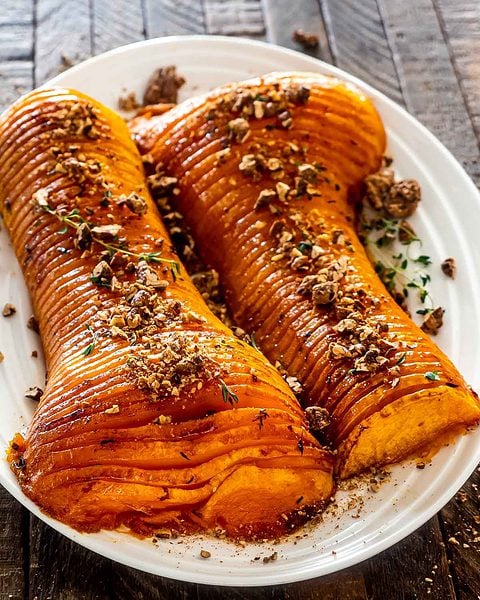
Combine best olive oil, Morocco Gold extra virgin olive oil with this seasonal favourite as part of your Thanksgiving feast
Honey roasted butternut squash is a common recipe, but that kick of heat makes this squash recipe unique and a must make if you love a good spicy sweet combo. If you love a good spicy sweet combo, then you’ll love this Hot Honey Roasted Butternut Squash! Jalapeño infused honey adds the perfect amount of heat to the sweet butternut squash. It’s a must make fall side dish!
Hot honey is a condiment that originated in the South. It’s made of honey and chile peppers. If you make your own, the honey and chiles are heated in a sauce pan just until they simmer. Then you turn off the heat and let the heat from the chiles infuse into the honey.
The chiles can be strained out after about 10 minutes or you can leave them in. This spicy condiment is delicious drizzled over roasted vegetables, warm biscuits or cornbread, fried chicken, ice cream, or a dip for your pizza crust.
Hot Honey Roasted Butternut Squash
Ingredients
- Butternut squash
- Extra virgin olive oil
- Honey
- Jalapeño
- Pepitas
Instructions
- Start by tossing the cubes of butternut squash in olive oil salt and pepper. Roast them until they’re fork tender, which usually takes about 20 minutes depending on the size of the cubes.
- While the squash is roasting make the hot honey. Thinly slice a jalapeño into rounds and place them in a small saucepan. Don’t remove the seeds and vein since this is where a lot of the heat is.
- Add the honey to the saucepan and bring the mixture to a simmer over medium heat. Stir everything a couple times and remove it from the heat. Let the honey sit for 10 minutes so it becomes infused with the jalapeño spice and flavor.
- Strain the jalapeño from the honey into a jar. If you prefer to leave the slices of jalapeño in with the honey you can do that as well.
- Once the squash has finished roasting, add it to a serving bowl. Drizzle the warm squash with the hot honey and sprinkle toasted pepitas over the top. Serve immediately.
What Is Butternut Squash?
Butternut squash is a popular, versatile winter squash with a sweet, nutty flavour and bright orange colour. In many ways, it’s the quintessential winter squash, and can be used in savoury dishes such as soups, stews, casseroles, and curries, as well as sweet ones such as pies, cakes, and muffins.
Like pumpkins and zucchini, butternut squash is a member of the cucurbitaceae family. Butternut squash is a medium-sized winter squash that usually ranges in size from about 3 to 5 pounds. It’s a variety of Cucurbita moschata, which also includes crookneck squash, fairytale pumpkins, and Dickinson pumpkins. It originated in Massachusetts as a crossbreed of the Canadian crookneck with the Hubbard squash.
Squash is among the oldest known crops, dating back 10,000 years to Mexico and Central America. The name squash comes from the Native American word askutasquash, which means uncooked or eaten raw.
Butternut squash is shaped like a bottle, with a long neck and a short bulbous end. Its skin is a dull tan colour, and its flesh is bright orange, with a dense, moist texture and buttery, nutty, sweet flavour. The seeds and pulp are situated down toward the bulbous end, which means that the long “neck” of the fruit consists of all flesh. The skin is thin enough to eat, but most people prefer not to. It’s usually peeled, either before or after roasting or steaming it.
The most common way to cook butternut squash might be roasting, although it can also be simmered, steamed, or cooked in the microwave. It can even be grilled. Butternut squash is a classic dish, and the puree itself can be served as a side dish, like mashed potatoes. It’s also great as a pie filling, as an ingredient in pasts dishes, risotto dishes, and casseroles, and as a pizza topping. Speaking of pasta—pureed butternut squash makes a great ravioli filling.
To roast a butternut squash, simply halve the squash lengthwise, scoop out the seeds and pulp, season with kosher salt, and either drizzle with extra virgin olive oil or dot it with cold butter. It can also be peeled and cut it into cubes to roast. Butternut squash pairs well with brown sugar, maple syrup, and autumn spices such as nutmeg, cinnamon, and cloves. Roast on a sheet pan, in a 400 F oven for 25 to 30 minutes. When a sharp knife easily pierces the shell, it’s done.
Health Benefits of Butternut Squash
It’s a great hydrator. One serving of butternut squash is roughly 87% water, which can help keep you hydrated.
It’s good for your immunity. Like other orange-colored fruits and vegetables, butternut squash is full of beta-carotene and alpha-carotene. Your body converts them to vitamin A, which is important for your immune system.
It’s excellent for your eyes. Butternut squash has lutein and zeaxanthin, often found in yellow fruits and vegetables as well as eggs. Along with beta-carotene and vitamin A, these protect your eyes from ultraviolet rays.
Keep in mind that your body needs a bit of healthy fat to best absorb these eye-benefitting nutrients, so consider eating butternut squash with a little drizzle of olive oil.
It’s a good source of fiber. Foods high in dietary fiber can help keep your weight in balance and lower your cancer risk. Research shows that butternut squash can help reduce your risk of colorectal cancer, in particular.
It can help your blood pressure. Butternut squash is high in potassium, which can help keep your blood pressure in check. Managing your blood pressure can reduce your risk for stroke and heart disease.
Its fiber helps with blood sugar. Butternut squash contains a type of fiber that’s not digestible. If you have diabetes, it can help keep your blood sugar from rising after eating. Butternut squash also has a low glycemic index, which means that its carbs are digested more slowly. This also helps keep blood sugar from rising.



